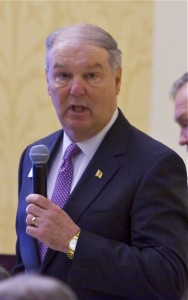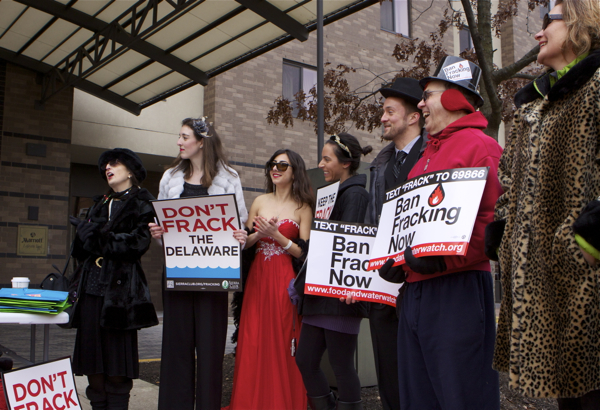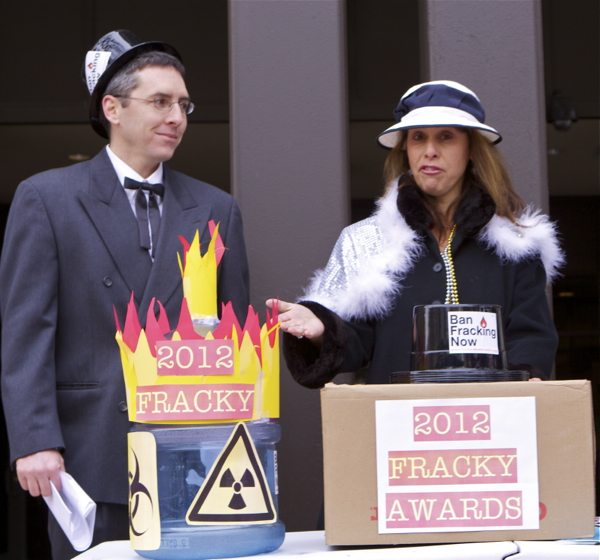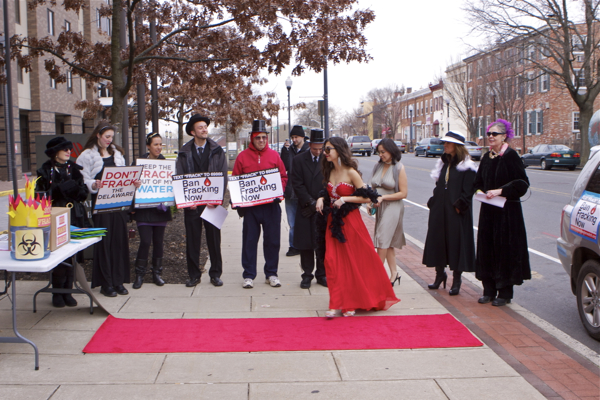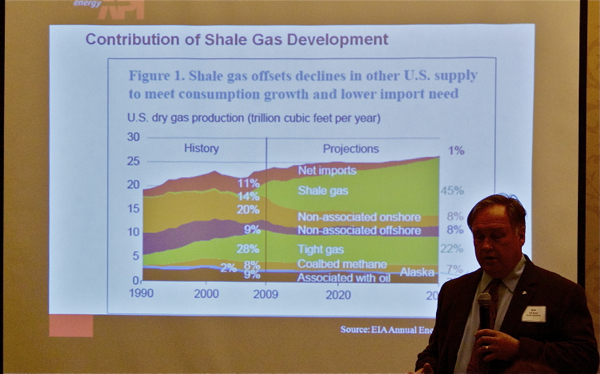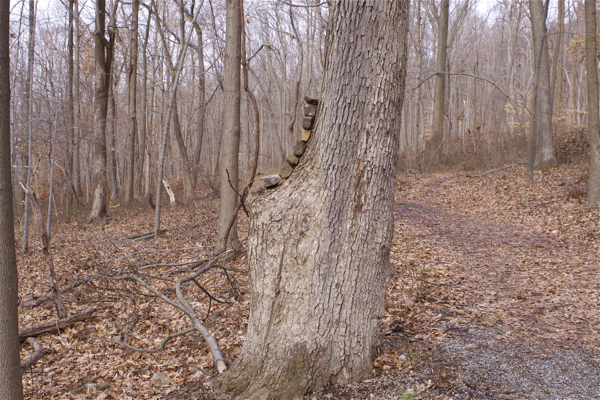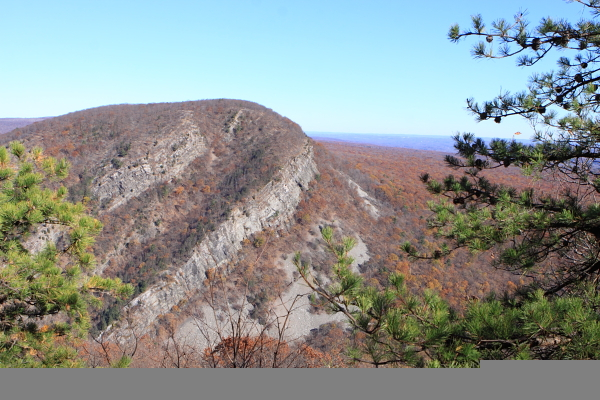Decade of coverup – Revolving Door at EPA – Local Politics – DEP Ethical lapse
You have my commitment that the Environmental Protection Agency will ensure that Dupont will fulfill its RCRA obligations for this facility. ~~~ Judith Enck, EPA Region 2 Administrator – October 2010 letter
I apologize, but this must be a lengthy post because I must reprint the full text of an important document that I don’t have a link to. Who knows, there may be an intrepid reporter, lawyer, or regulator out there! (HINT!)
So let me just catch up on what’s gone down since last week’s Community rally and EPA public hearing.
First, a few glimmers of hope and good news:
Let’s hope that they focus on Dupont’s ecological assessment; the scope and extent of the cleanup; and document compensable natural resource damages.
I raised the requirement to consult with USFWS and flagged some ecological issues at the EPA informal October 19, 2010 presentation of the Dupont Acid Brook Delta Plan. So, it really pissed me off that between then and the January 5, 2012 formal public hearing, EPA staff failed to get back to me or to formally consult with US FWS.
The whole purpose of the informal hearings is to flag issues and for staff to respond to them – it simply boggles the mind that EPA staff failed to respond, especially given EPA Region 2 RA Judy Enck’s personal pledge to me and the Pompton Lakes community.
We tweeted the letter last week, but see the Record’s story: Superfund designation sought for Pompton Lakes pollution sites (gee, do you think they could put polluter Dupont’s name in the headline?)
- Last week, more than 40 residents braved the cold to protest the Dupont plan, present a petition with over 7,000 signatures, and urge EPA to designate the Dupont site a national priority under the Superfund program. Ramped up pressure and protest can only help.
Now for the bad news.
1) Vapor Intrusion coverup: A decade long failure to warn and take action
At the [Jan 5, 2012] Dupont [RCRA] public hearing, one of the points I made (which I wrote about in F is for Fraud) was to question who knew what when on the chronology of the vapor intrusion issue and ask why residents were not warned about the poisoning and risks in their own homes.
If people knew, they could take action to prevent exposure to chemicals in their home.
I simply find it difficult to believe that one of the most scientifically and legally sophisticated chemical corporations in the world didn’t understand the vapor problem until the 2008 disclosure and that the timing of the 2008 disclosure had nothing to do with a legal liability settlement deal reached to end litigation.
After the public hearing (I assume in response to my testimony on this issue), someone sent me a trove of DEP emails regarding behind the scenes negotiations with Dupont and EPA (more to follow on that), including the below timeline (probably prepared as a CYA by NJ DEP).
This closed door process would never had happened if the Dupont site was cleaned up under Superfund, as should have happened back in 1982, when EPA conducted an HRS scoring and the site qualified based on risks.
Under Superfund, residents would have a seat at the table and be involved in all the back room secret discussions between Dupont, NJ DEP and EPA listed below – which began over 10 years ago!
Additionally, I was not aware that the groundwater plume that is the source of the vapor intrusion was a “CEA” – a loophole in cleanup requirements known as a groundwater “Classification Exception Area” – under NJ DEP cleanup regulations.
Without going into all the technical details here, this raises significant regulatory and legal issues, if for no other reason that federal EPA RCRA regulations do not recognize a NJ State CEA and that Dupont was required to certify the safety of that CEA. How could EPA have signed off on RCRA compliance and certified the Dupont site under RCRA?
As is obvious from this timeline, Dupont, NJ DEP and EPA regulators were in no hurry and failed to notify homeowners about risks.
These failures occurred despite the fact that vapor intrusion is a direct contact exposure and a public health risk that equalifies as an “immediate environmental concern” (IEC) under NJ DEP regulations. How did Dupont certify that the CEA was in compliance? How did DEP accept this certification?
Vapor intrusion also is of direct relevance to US EPA Assessment of Environmental Indicators – groundwater and human exposure under control – (CA725 and CA750 – see below) EPA must certify to Congress pursuant to the Government Performance and Results Act of 1993 .
Du Pont Pompton Lake Works Site
TIMELINE
Vapor Intrusion Pathway
Trenton meeting with DuPont officials (mentioned VI pathway must be addressed) Â Â Â Â 03-30-01
USEPA Assessment of Environmental Indicators (CA725 and CA750) Â Â Â Â Â Â Â Â Â Â Â Â 12-20-01
John Boyer’s review of South Plant Region RIR (requires VI assessment on-site)      03-13-03
Teleconference with DuPont re: meeting next week & EI Determination of VI Pathway  05-23-03
DuPont provides letter “Indoor Air Evaluation for Four DuPont NJ Sites†           05-30-03
Diane Groth’s review of Environmental Indicators Evaluation of Vapor Intrusion       08-27-03
John Boyer’s review of Environmental Indicators Evaluation of Vapor Intrusion        09-11-03
Teleconference with DuPont, consultant, re: Vapor Intrusion assessment                   09-17-03
NJDEP Review of “Initial Indoor Air Assessment†                                  09-19-03
John Boyer’s review of Proposed GW Sampling in Support of EI Determination       11-07-03
John Boyer’s email to Barry Tornick (USEPA) on GW Investigation for EI           11-14-03
DuPont Progress Update on VI Investigation for EI Determination                 12-12-03
John Boyer’s review of “Update on GW Sampling in Support of EI Determination     02-03-04
NJDEP’s review of “Update on GW Sampling in Support of EI Determination        02-09-04
Diane Groth’s email regarding basis for TCE/PCE screening levels for VI            02-10-04
John Boyer’s review of “Update on GW Sampling in Support of EI Determination     05-13-04
John Boyer’s review of Summary of GW/SG Results for RCRA EI Deter (VI)        05-04-05
John Boyer’s review of Response to Comments Letter (VI)                      07-11-05
Trenton meeting re: indoor air sampling requirements                           02-15-06
John Boyer’s review of Vapor Intrusion Investigation Work Plan                        02-21-06
Response of VI Investigation Workplan Response                                   05-03-06
Trenton meeting with EPA, DuPont re: indoor air sampling                       01-31-07
Development of Anticipated VI Screening Levels                                    02-09-07
John Boyer’s Review of Vapor Intrusion Investigation & Remedial Action Work Plan   07-20-07
DuPont’s 3rd Quarter 2007 Progress Report (mentions various email correspondence)  11-31-07
Trenton meeting with Barry Tornick (EPA) Â Â Â Â Â Â Â Â Â Â Â Â Â Â Â Â Â Â Â Â Â Â Â Â Â Â Â Â Â Â Â Â Â Â Â Â Â Â Â Â 12-06-07
DuPont’s Response to NJDEP comments on VI Investigation & RA Work Plan             01-15-08
John Boyer’s review of DuPont’s response to NJDEP comments on VII & RAWP    01-16-08
NJDEP’s Approval of VI Investigation & RA Work Plan                              01-16-08
DuPont’s 4th Quarter 2007 Progress Report (mentions various email correspondence)  01-31-08
Teleconference re: vapor intrusion sampling implementation                       02-14-08
Teleconference re: vapor intrusion sampling implementation                       03-06-08
Site visit re: sub-slab soil gas sampling at residential house                        03-20-08
DuPont’s Proposed Sub-Slab Vapor Sample Collection Procedures for Building SSDS 04-15-0Du Pont Pompton Lake Works Site
Dupont Pompton Lakes Site
TIMELINE
Vapor Intrusion Pathway
Trenton meeting with DuPont officials (mentioned VI pathway must be addressed) 03-30-01
USEPA Assessment of Environmental Indicators (CA725 and CA750) 12-20-01
John Boyer’s review of South Plant Region RIR (requires VI assessment on-site) 03-13-03
Teleconference with DuPont re: meeting next week & EI Determination of VI Pathway 05-23-03
DuPont provides letter “Indoor Air Evaluation for Four DuPont NJ Sites” 05-30-03
Diane Groth’s review of Environmental Indicators Evaluation of Vapor Intrusion 08-27-03
John Boyer’s review of Environmental Indicators Evaluation of Vapor Intrusion 09-11-03
Teleconference with DuPont, consultant, re: Vapor Intrusion assessment 09-17-03
NJDEP Review of “Initial Indoor Air Assessment” 09-19-03
John Boyer’s review of Proposed GW Sampling in Support of EI Determination 11-07-03
John Boyer’s email to Barry Tornick (USEPA) on GW Investigation for EI 11-14-03
DuPont Progress Update on VI Investigation for EI Determination12-12-03
John Boyer’ss review of “Update on GW Sampling in Support of EI Determination” 02-03-04
NJDEP’s review of Update on GW Sampling in Support of EI Determination 02-09-04
Diane Groth’s email regarding basis for TCE/PCE screening levels for VI 02-10-04
John Boyer’s review of Update on GW Sampling in Support of EI Determination 05-13-04
John Boyer’s review of Summary of GW/SG Results for RCRA EI Deter (VI) 05-04-05
John Boyer’s review of Response to Comments Letter (VI) 07-11-05
Trenton meeting re: indoor air sampling requirements 02-15-06
John Boyer’s review of Vapor Intrusion Investigation Work Plan 02-21-06
Response of VI Investigation Workplan Response 05-03-06
Trenton meeting with EPA, DuPont re: indoor air sampling 01-31-07
Development of Anticipated VI Screening Levels 02-09-07
John Boyer’s Review of Vapor Intrusion Investigation & Remedial Action Work Plan 07-20-07
DuPont’s 3rd Quarter 2007 Progress Report (mentions various email correspondence) 11-31-07
Trenton meeting with Barry Tornick (EPA) 12-06-07
DuPont’s Response to NJDEP comments on VI Investigation & RA Work Plan 01-15-08
John Boyer’s review of DuPont’s response to NJDEP comments on VII & RAWP 01-16-08
NJDEP’s Approval of VI Investigation & RA Work Plan 01-16-08
DuPont’s 4th Quarter 2007 Progress Report (mentions various email correspondence) 01-31-08
Teleconference re: vapor intrusion sampling implementation 02-14-08
Teleconference re: vapor intrusion sampling implementation 03-06-08
Site visit re: sub-slab soil gas sampling at residential house 03-20-08
DuPont’s Proposed Sub-Slab Vapor Sample Collection Procedures for Building SSDS04-15-08
This delay is sickening, disgraceful and totally unacceptable.

Barry Tornick – oversaw Dupont site in career w/EPA
2) EPA blocks public participation – revolving door at EPA
The EPA region 2 staff person overseeing this mess was Barry Tornick, head of the EPA Region 2 RCRA program.
After more than 7 years of delay, secrecy, and closed door meetings with DEP and Dupont, when the time finally came for action, Tornick subverted RCRA public participation requirements. Here is his May 14, 2008 email recommending that Dupont and DEP avoid RCRA public participation requirements (an email that could have been written by Dupont’s lawyers):
>>> <Tornick.Barry@epamail.epa.gov> 05/14/2008 12:02 PM >>>
Maybe we should consider this a Interim Remedial Measures Workplan instead of a Remedial Action Workplan since we want to expedite it and to take a less formal public participation approach than for a remedial action?
So EPA bent the RCRA regulations to avoid public participation. Again, that could not happen under Superfund.
Now, in a supreme irony – you can’t make this stuff up – to add insult to injury, we learn that Tornick has just retired from EPA and is now working for a polluter at a NJ Woodbrook Road Dump Superfund site – and the site is located directly adjacent – virtually in the backyard of – the Edison Wetland Association’s land in Edison!
3) Local politics and ethical lapses at DEP
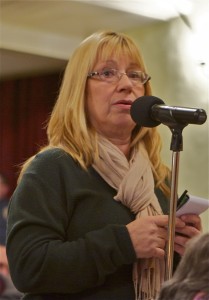
Ms. Kent – DEP employee and local political hack
[Update: I just received email from the DEP Ethics Officer that indicates that Ms. Kent clarified the record by submitting a disclaimer to EPA. I will also note here that I intervened with Commissioner Martin on this very reluctantly. I don’t like to do anything to suppress free speech, especially of DEP employees. But this seemed like an egregious example of politics to me and not a good faith exercise. ]
It is no secret that a local faction in Pompton Lakes – including Mayor Cole – is working with Dupont and opposing the Superfund designation by EPA.
Among other things, this group is exaggerating the so called negative economic and “stigma” impacts of a Superfund designation and spreading false and misleading information about Superfund and how it would work at the Dupont site.
It is also no secret that DEP has little credibility or trust among Pompton Lakes residents, or that EPA has taken over lead control of the site from the DEP due to DEP mismanagement and lack of community support.
So, given the sensitivity of these DEP related issues, I was surprised that during the hearing, a woman named Maria Kent, who identified herself as a Chair of the “Environmental Committee” and a DEP employee, spoke in support of the Dupont plan.
I assume that the “Envrionmental Committee” is NOT an “Environmental Commission” and that Ms. Kent was appointed by Mayor Cole for political reasons. Muddying the political waters further is the fact that Ms. Kent’s husband is a PL Township Committee member.
To establish a real Environmental Commission, the full governing body needs to pass an ordinance pursuant to state enabling legislation at NJSA 40:56A et seq. .
During her remarks, Ms. Kent did not affirmatively state that her views did not represent the views of DEP, as required under DEP Ethics Code.
Worse, in addition to these ethical lapses, Kent mislead the public about threats of Congress not funding Superfund cleanups.
Without any evidence, she claimed that she was aware of a NJ Superfund site where work had stalled on construction of site infrastructure – and that if Congress didn’t appropriate money, then the Dupont site cleanup could stall if it were in the Superfund program.
The latter claim is false. I wrote the below letter to DEP Commisisoner Martin to respond to this ethical lapse:
Dear Commissioner Martin:
On January 5, 2012, a DEP employee named Maria Kent testified at a controversial EPA public hearing in support of a proposed draft RCRA permit modification for the controversial Dupont Pompton Lakes site.
As you know, pursuant to federal RCRA authority, EPA recently revoked certain aspects of DEP’s lead oversight over certain aspects of the cleanup of that site.
During her testimony, Ms. Kent stated that she was Chair of the Pompton Lakes Environmental Committee and a DEP employee. I also understand that Ms. Kent’s spouse, Lloyd Kent, is a Pompton Lakes Council member.
However, I do not recall hearing any clear statement by Ms. Kent to the effect that her testimony did not represent the views or policies of the DEP.
My understanding of the DEP ethics code is that such a clear disclaimer is required under these conditions.
In fact, when I was a DEP employee and a school board member in North Hanover NJ, the DEP ethics Officer at the time issued a memorandum to me that REQUIRED that I read such a disclaimer into the public record during a school board meeting. This disclaimer was required even for DEP issues before the school board that were unrelated to my DEP job responsibilities.
Accordingly, I urge you to look into this matter and direct Ms. Kent to submit a written disclaimer comment to EPA be made a part of the administrative record on the RCRA permit.
The comment period on the draft permit ends on January 13, 2012.
I also urge you to issue ethics Guidance to all DEP employees regarding similar external activities.
Please confirm that these actions have been taken, or provide a written response should you decline this request.
Sincerely,
Bill Wolfe
(writing here as a citizen – not on behalf of NJ PEER or in my capacity as NJ PEER Director)
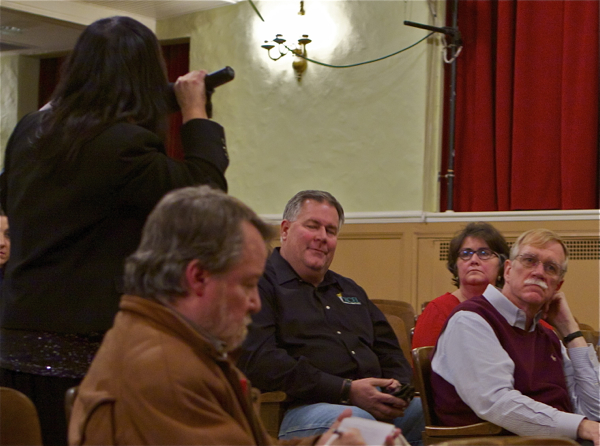
Lisa Riggiola (back turned on left, w/microphone) criticized Mayor Cole (R, in red)during comments at Dupont RCRA permit hearing on Acid Brook cleanup plan

